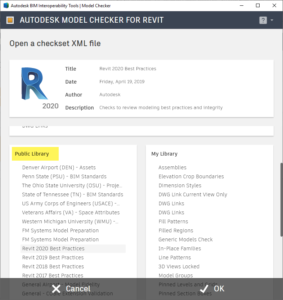We worked with Autodesk recently to develop and post a new checkset XML to the Model Checker for Revit Public Library. Well, four new checksets really, but they are pretty much the same one for different years of Revit.
If you aren't familiar with the Autodesk Model Checker for Revit, it's a great free add-on for Revit that lets you review data, parameters, and other select items in your Revit model in a fast and reliable fashion.
If you aren't familiar with the Model Checker Public Library, it's just a section of the open dialog that lists publicly available checkset XMLs for anyone to grab and use. It looks like this:
If you haven't looked at the list of available checksets in a while, this might be a great time to take another look.
What's in the Revit Best Practices Check
The check itself is full of useful items to review. It's not a total catch-all, but it has many generally accepted things that model managers and general Revit users like to keep an eye on. Many are not "Pass/Fail" checks, but Counts and Lists of elements matching the check's criteria, giving you a single report to monitor the growth of a model through the design process.
It's broken into seven sections:
Model Performance
Checks that relate to the overall model integrity like file size, family sizes, warnings, and purgeable elements.
Project Settings
This section gives you information on the model's options, phases, worksets, and user editable checks for coordinates, in addition to others.
External Files
Anything about linked and imported DWGs, Sketchup files, images, and related checks are here.
Datum and Location Elements
Reports and checks related to levels, grids, rooms, spaces, and areas can be found here.
Views
This section will report on views, schedules, and sheets, but also try to guide best practices by reporting on views that have no view template, views with hidden elements, etc.
Model Elements
Lists and reports of different categories of elements are here, but also model element related issues like duplicate elements.
Annotative Elements
Similar to the Model Elements section, but reporting on annotative elements.
What's Different About the Checks
You'll see four new checksets - Revit 2020 Best Practices, Revit 2019 Best Practices, Revit 2018 Best Practices, and Revit 2017 Best Practices. They are pretty much identical. The difference is in the categories because in each Revit release some categories are added and some removed from Revit. If the Model Checker tries to report on a category that doesn't exist, Revit gets really angry.
What Else Can You Do With It
The checkset itself might be a little too much for your needs. No problem! It's a great starter checkset for you to download and edit with the Model Checker Configurator. Many of the checks highlight some of the new built-in checks in the Model Checker, and most are great common sense things to watch in your Revit model.


